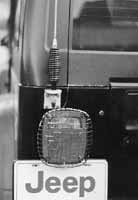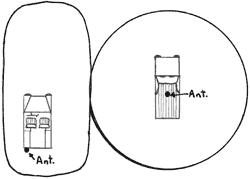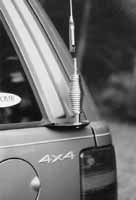![]()
MOUNTING ANTENNAS
Where, oh where, should the CB antenna be mounted? I bet every off roader asks themselves this question, or should...
A CB antenna is made up of two parts, the vertical element (antenna) you buy in the store and the metal ground plane that the vertical antenna is attached to and radiates from. When selecting a location on your vehicle to mount your CB antenna, you are actually designing the other half of the antenna system.
The antenna that you buy would really like to be mounted on top of a metal cone that extends down 102" from the base of the antenna at approximately a 45-degree slope. This allows for equal radiation 360-degrees around the transmitting antenna. If you can picture a Volkswagen bug with the antenna centered on the roof, this is about as close to electrical perfection that a vehicle can come. The center top is the most efficient mounting location, plain and simple. Keep this in mind throughout this article and let's talk practicability.
 If
you have a soft-top, a fiberglass top, or you wheel with low trees that
slide over the roof, an antenna placed on top may not be an option. The
next best place, of course, is the second most flat surface on the vehicle,
the center of the hood or trunk lid. Since a large antenna in the middle
of the hood looks ridiculous and very few 4X4's have trunks, let's move
on. If a steel roof top location is not available, say in a jeep, I like
to see the antenna placed above the driver's side taillight on the rear.
This mount allows some protection from the trees and being on the driver's
side usually allows a long whip to have a better chance of clearing low
limbs on country roads.
If
you have a soft-top, a fiberglass top, or you wheel with low trees that
slide over the roof, an antenna placed on top may not be an option. The
next best place, of course, is the second most flat surface on the vehicle,
the center of the hood or trunk lid. Since a large antenna in the middle
of the hood looks ridiculous and very few 4X4's have trunks, let's move
on. If a steel roof top location is not available, say in a jeep, I like
to see the antenna placed above the driver's side taillight on the rear.
This mount allows some protection from the trees and being on the driver's
side usually allows a long whip to have a better chance of clearing low
limbs on country roads.
The mount should be as high up on the tub, as you can get it (just below the lip), for two reasons. First so there is enough clearance between the bottom of the mount and the taillight so that you can hook up the lug connector. Second, and the most important, the antenna sees a relatively flat surface to radiate from, this being the top rim of the tub. The antenna will see two almost horizontal 102"= radials. One being the top edge of the tub on the driver's side, the other across the top edge of the back and along the passenger's side.
 While
you have this pictured in your mind, I would like to mention radiation
patterns. This is the footprint of the direction of the best distance
your radio transmits. Because the body of the vehicle is an integral part
of the antenna system, it is relatively easy to estimate in which direction
your vehicle will transmit best. As the antenna uses the body to radiate
off, the general rule of thumb is that you will transmit best in the direction
of the body mass. So if you have a Jeep with the antenna located on the
rear driver's side, you will transmit better in the direction that the
front passenger side points towards. Very good if you are tail gunning
a trail, poor if you are the trail leader. Knowledge of this can be an
advantage because you can then turn your vehicle in the direction you
wish to talk, especially beneficial in emergencies.
While
you have this pictured in your mind, I would like to mention radiation
patterns. This is the footprint of the direction of the best distance
your radio transmits. Because the body of the vehicle is an integral part
of the antenna system, it is relatively easy to estimate in which direction
your vehicle will transmit best. As the antenna uses the body to radiate
off, the general rule of thumb is that you will transmit best in the direction
of the body mass. So if you have a Jeep with the antenna located on the
rear driver's side, you will transmit better in the direction that the
front passenger side points towards. Very good if you are tail gunning
a trail, poor if you are the trail leader. Knowledge of this can be an
advantage because you can then turn your vehicle in the direction you
wish to talk, especially beneficial in emergencies.
 On
a pickup truck with a canopy or an SUV like an Explorer, if you decide
a hood-mount suits your situation, locate the antenna halfway between
the front of the truck and the windshield pillar on the driver's side.
You don't want to mount the antenna too close to the vertical metal of
the windshield pillar or this will make a weird reflection and possibly
make the antenna untuneable. The closer you mount it to the front of the
truck the worse you will transmit in the forward direction.
On
a pickup truck with a canopy or an SUV like an Explorer, if you decide
a hood-mount suits your situation, locate the antenna halfway between
the front of the truck and the windshield pillar on the driver's side.
You don't want to mount the antenna too close to the vertical metal of
the windshield pillar or this will make a weird reflection and possibly
make the antenna untuneable. The closer you mount it to the front of the
truck the worse you will transmit in the forward direction.
Where not to mount the antenna? The front bumper has to be one of the worst choices for an off roader. It is highly susceptible to damage and it runs parallel to the vertical grill face, possibly touching at highway speeds. Even if you can tune it up with a SWR meter, as discussed in the last issue, where is it going to transmit? Not off the front of the vehicle because there is no body mass. Not off the rear of the vehicle as it has to climb 1-2 feet before it will see a level surface. What you would see is some type of suppressed footprint (radiation pattern) that is reflected off the front grill. The fact is, avoiding mounting the antenna near anything that moves, like a door or hatch, as it may not be well grounded to the entire vehicle. Also, unless you have a high grade, military spec. Coax that has a multi-strand center core, it will not take the constant flexing when the hatch or door is opened or closed.
Why not have two mounts? One should be acceptable for the tight overhead trails when you're moving through the bush and another, dead center on top of your SUV or canopy for back at base camp or driving the open rock canyons of Moab. When mounting on the roof, try to pick up the roof cross member for support. An access can usually be found via the hole in the headliner by temporarily removing the interior dome light. On a canopy there should be no problem putting a mount on the front edge, which is basically the center of the vehicle.
Quick disconnects are available to allow your antenna to be removed for the garage or to quickly move the antenna between various mounts or vehicles. To use two antenna mounts means two coaxes. You will have to either manually change the connection at the rear of the radio or buy a coax switch and possibly a short jumper coax. Under no circumstances use a "tee" fitting for anything concerning CB or Amateur Radio. I would far rather spend an extra $50.00 on a well placed second mount than on any extra doo-dads you can find on a CB.

|

|

|

|

|
| comcorner01.jpg | comcorner02.jpg | comcorner03.jpg | comcorner04.jpg | comcorner06.jpg |
Other Issues: Coax
cables | SWR Meters | Antenna
Mounting
Communications Corner Home
![]()